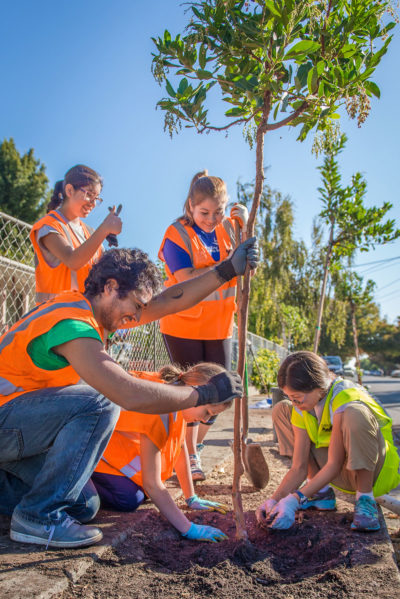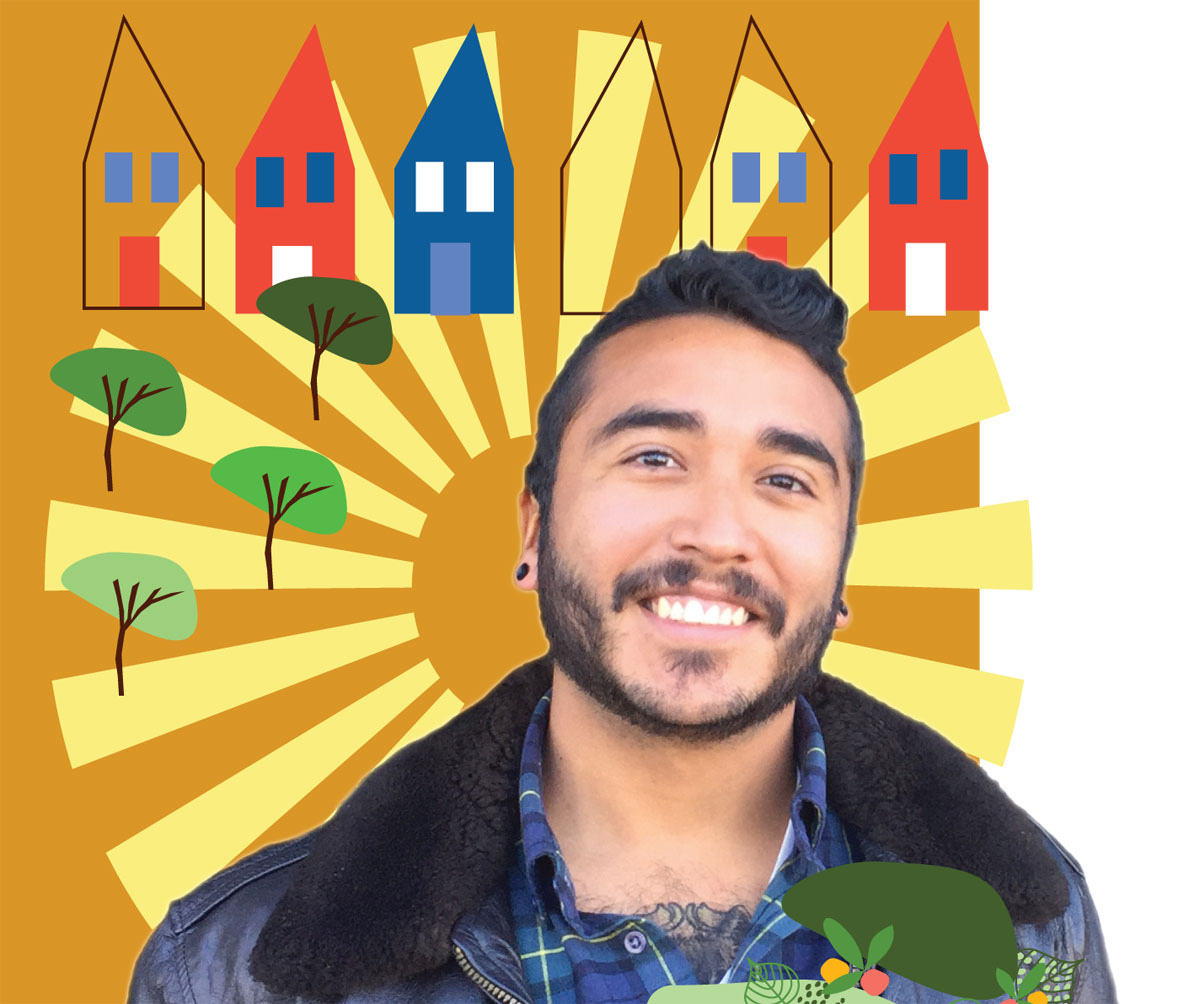Uriel Hernandez opens the gate of an elbow-high, chain-link fence and knocks on the front door. The house, a modest single-story dwelling in a tidy neighborhood of East Palo Alto, has a healthy patch of grass lined with dormant rose bushes, and a dead yucca tree.
An elderly woman answers in a housedress and slippers this Saturday morning. Uriel coaxes: “Hiiiyy, good morning, how’re you doing?” She’s warm and cheery right back: “Great, doin’ alright. I’m an old lady, I’ll be okay.”
Uriel gets down to business. “So, we talked on the phone yesterday, and we’ll be in your neighborhood on February 11th [planting trees]. So, we can probably get that tree removed and plant something else… Let’s figure out another tree. You said avocado? Would you mind two trees? Because we’d also like to plant a big tree.” She says: “Just give me as many as you could. Just fill me up with them!”
That’s music to Uriel. In August, the urban forestry nonprofit Canopy put Uriel in charge of the Branching Out initiative, a recipient of proceeds from California’s cap-and-trade program to drastically slash the state’s carbon emissions by 2020. Uriel’s tall order is to make sure 500 carbon-trapping trees are planted in the socioeconomically disadvantaged town of East Palo Alto by that deadline. And so he pounds the pavement of his hometown, directing a half-dozen TUFs (teen urban foresters) to fan out with clipboards and ready smiles to try to persuade the residents, one by one, of the merits of having more greenery in their lives —better air, more beauty, and lower energy bills.

Affable and persistent, Uriel, 25, is ideal for the job—and he’s finding his footing as a community leader. He regularly tables at schools and community events to promote trees and, importantly, to build a volunteer base for his planting efforts in the area. As Canopy’s community forestry coordinator, he oversees the planting and maintenance of more than a thousand trees in the group’s service area of East Palo Alto, Palo Alto, and Menlo Park.
His hard work is proving fruitful. In October, he organized a community work party of 80 volunteers in East Palo Alto that planted 72 trees in this same University Village neighborhood, becoming the largest neighborhood tree-planting event in Canopy’s 20-year history. But for Uriel, the trees—and the work parties he organizes to put them in the ground—are the backdrop for a deeper purpose.
“There are the obvious long-term benefits of trees … but I’m often more focused on the immediate benefits of bringing people out for service work and becoming more engaged and taking pride in their community. They hear about trees and they start caring about the condition of their neighborhood and taking action. You get the new people who just moved in and the old people coming out and intersecting with each other.”
Surrounded by some of Silicon Valley’s poshest towns, East Palo Alto has long been a redoubt for working-class communities of color. The town of 30,000 has dealt with the usual challenges that come when 28 percent of the population lives below the poverty line—too much asphalt and concrete being just one of them. With Facebook on the town’s northern flank and a revved up housing market, East Palo Alto is facing the forces of gentrification, another source of tension in the community, Uriel explains.
“East Palo Alto is really at a crossroads where it can go in many different ways. People can come in and completely change the identity of this city and turn it into just another suburb. But right now, East Palo Alto is kind of this oasis of culture. People came here because they didn’t have anywhere else to go. This city has a long history of doing its own thing.”
Uriel is a part of that history. Born to immigrant parents—his father a certified nurse assistant from Mexico and his mother a nurse from Nicaragua who fled the country’s civil war—Uriel grew up in a home not far from where we’re canvassing. It was his Nicaraguan great-grandmother, Bertha, who often put him and his siblings to bed while his parents worked late into the evening. She claimed a spot in the center of the backyard for a peach tree, which she carefully tended. “It wasn’t the biggest tree in the backyard. All the other trees I would play on and pull the branches, but the peach tree was my great-grandmother’s tree and you respected it and took care of it.” Uriel lifts his shirt and shows me a large tattooed peach tree spanning his shoulder blades, the fruit softly colored among the spreading branches. “It’s a reminder of home and of simpler times,” he says.
Beyond his beloved peach tree, Uriel says his early life didn’t include much venturing into the wild. “It’s just not something my family did, culturally. People of color don’t camp and hike as much, and at school there was a lack of exposure to nature. Growing up in the Bay Area, yeah, nature is all around but I wasn’t immersed in it.”
But he says he was always fascinated with nature. Then, as a junior in high school he got the chance to head to Vermont for a semester with the Mountain School, where he worked on a farm and got his first taste of forestry. That intensive experience set him off on a new trajectory. “I was immersed in nature in Vermont,” he says. “When I came back home, I was really able to see it every day in the Bay Area.”
Two years later he was back in Vermont pursuing a bachelor’s degree in architecture at Middlebury College, where he developed a sense of how to bring nature into a built environment—especially in places that are lacking it. “Architecture is all about designing an experience. You have to walk through buildings and feel the space around you. That’s what attracted me to trees. Trees make you feel a certain way. I want tree equity. I want everybody in East Palo Alto to have a nice, tree-lined street.”
Going door to door, though, he’s found that not everyone in the community feels that way. Canopy offers a pretty good deal to residents: The trees are free and come with a guarantee of four years of pruning and other maintenance. But that morning, Uriel talks to a man cleaning out the gutters on his roof who wasn’t ready to line his sidewalk with a couple of trees: “You know what, let’s just pass on that for next time,” the man says. It’s also a no-go with an elderly woman in a walker who smiles and says, “I don’t think I need any more trees … this is plenty.” He hands her a brochure and soft-sells her into spreading the word around. “Okay, I’ll be asking,” she says. “Thanks a million.” Out of earshot, Uriel says: “She’s super sweet. A lot of these old residents are pretty good about passing on the word. They’ll talk to their pastor, their church.”
Uriel explains his sense of the response: “For a while there was a push to get rid of a lot of trees in East Palo Alto because people were scared that people would hide behind them and commit crimes. That’s something I hear way too often when I go door to door and talk to people about trees. And then other people don’t want trees because they’re not-in-my-backyard type people. There are a lot of homeowners who rent out their property … and don’t want to deal with the hassle.” He has his work cut out for him.
Uriel found his way to Canopy in 2015. He’d moved back to East Palo Alto to stay with his family after graduating, and within a year he was working with Canopy. “Sometimes it’s a little strange because I never saw myself back here, but it’s just really nice, especially working in the schools. I like to see a lot of familiar faces. And I’ve really grown to appreciate the roots I have in East Palo Alto, with a new role and purpose.”
He’s not sure he’ll stay in his hometown forever. But for now he’s satisfied with the ordinary nature that surrounds him, like the trees he’s planted growing taller and sturdier, and the marshes he passes along his bike ride to work. “It’s not a national park, it’s just my backyard and I love it.” He’s helping others see that too.


